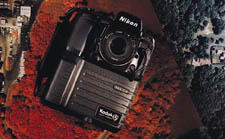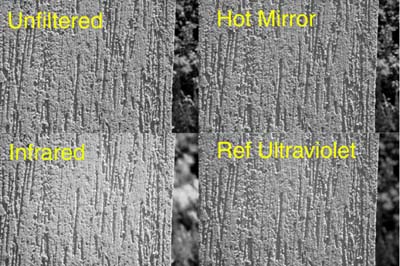
about | articles | authors | contact | links
 about | articles | authors | contact | links |
![]() Home > Articles > Infrared Photography > Electronic recording: Digital 'still' cameras
Home > Articles > Infrared Photography > Electronic recording: Digital 'still' cameras
INFRARED PHOTOGRAPHYAuthors: Prof. Robin Williams and Gigi Williams Electronic recording of the infrared image:
|
 |
Figure 56 (left). The DCS IR camera from Kodak with no integral infrared absorbing filter. |
A simple experiment will confirm whether a digital camera can be used for infrared. Set the camera up in a darkened room aimed at a television/video infrared remote control, making sure that the LCD screen is activated. The infrared emission of the remote control caused by pressing the control buttons should be visible on the camera's LCD if it can be used for infrared imaging.
The use of such cameras has some compelling advantages:
The technique of infrared photography with these cameras follows the same principles as with film based systems. An infrared transmission filter must be placed over the recording lens. As with film the choice of filter is a critical issue with CCDs. Many digital cameras (especially those with integral 'hot' - or infrared absorption - filters) will not record far into the infrared spectrum. For these cameras the selection of a pure infrared filter like theWratten 87C will almost certainly produce no result. A broader spectral transmission is required: the Wratten 89B is widely reporting as being excellent.
The infrared image records in the red channel of a composite R-G-B image, but a much better result can be achieved by switching the camera to monochrome or black-and-white image and selecting the highest resolution/least compression option available on the camera. It is always advantageous to record a colour 'control' photograph immediately before or after the monochrome infrared - without moving either camera or subject. This is useful for comparison purposes and aids interpretation of the infrared record enormously. It also enables the construction of a false colour infrared image if that is desirable, see Building a false colour image in Photoshop.
Digital cameras which use film-plane algorithms for focussing will autofocus an infrared image; others which use infrared sensors outside of the image forming path may not (especially if a large filter holder is obscuring the filed of view of the 'rangefinder' window. The authors tested a Nikon Coolpix 990 with infrared and ultraviolet radiation to check the autofocus at reasonable magnifications (Figure 57 ) and demonstrated that the autofocus capability worked well. One reason why out-of-focus results can be obtained is that the camera is 'asked' to focus both infrared and ultraviolet at the same time - all ultraviolet filters 'leak' infrared and many infrared filters leak ultraviolet - and the CCD is sensitive to visible, infrared and ultraviolet. It is imperative therefore that 'pure' infrared (or ultraviolet) is presented to the CCD by selecting appropriate filter combinations. For infrared, the infrared transmission filter, eg. Wratten 89B, needs to be supplemented by an ultraviolet absorbing filter, eg. A Wratten 2E. For ultraviolet imaging the reverse applies; the ultraviolet transmission filter, eg. Wratten 18A needs to be supplemented by an infrared absorbing filter or "hot mirror."

Figure 57 (above). The autofocus mode of the Nikon 990 digital camera evaluated. The images of a rendered wall demonstrate that the Nikon copes with each wavelength selected. The ultraviolet record was imaged by combining an infrared absorbing filter - 'hot filter' - with the Wratten 18A; whilst the infrared record was obtained by combining a Wratten 2E - ultraviolet absorbing filter - with the Wratten 89B infrared transmission filter.
The sensitivity of different CCD/over-filters varies enormously and it is impossible therefore to give any useful recommendations for exposure etc., except to say that exposures are likely to be very long - often several seconds with most continuous sources of radiation. Even with manually 'forcing' the camera to its maximum ISO setting and widest aperture one can expect 1/2 second exposures. A tripod and cable release are, therefore, de rigueur for this technique. One must, of course, disable any autoflash capability. With external electronic flash it is possible to record moving subjects, although again the 'slower' cameras will need to be manually controlled so as to override the autoexposure capability and ensure a wide enough aperture and high enough amplification from the CCD (highest equivalent film speed).
One consequence of forcing digital cameras to record such weak images is that the signal to noise ratio of the charged couple device is seriously reduced and noise becomes a problem in the final image. This 'dark field noise' has the effect of lots of pixel sized highlights in dark areas of the image. The noise is caused by an aberration of the charged couple device. The electronics themselves generate heat and this energy causes some pixel electrons to be activated and then trapped as 'false positives' ie. not generated by light energy falling on the pixel. This results in a blotchy image in dark shadow areas of the image: it becomes worse in hot conditions and with very long exposures. CCDs built into astronomical imaging devices (which have very long exposure times) are often super cooled in order to avoid this problem of noise. It is possible to 'filter' out this noise at a post imaging stage in an image manipulation software program such as Adobe Photoshop by a technique known widely in astronomy as dark field subtraction. Two images are required - one of the infrared record (with noise) and one with no ambient illumination (the noise). The image of the noise is then effectively subtracted from the real image using Photoshop's layer subtraction feature. A quick alternative is the use of a plug-in program like Quantum Mechanic which does the filtering for you. Quantum mechanic makes the reliable assumption that the noise artefacts are mostly in the chrominance channels of a colour image and leaves the luminance channel untouched. It is not however as effective as full manual dark field subtraction.
| © 2002 Prof. Robin Williams and Gigi Williams - Disclaimer URL: http://www.medicalphotography.com.au/Article_03/ Last modified: 3 May 2002 |